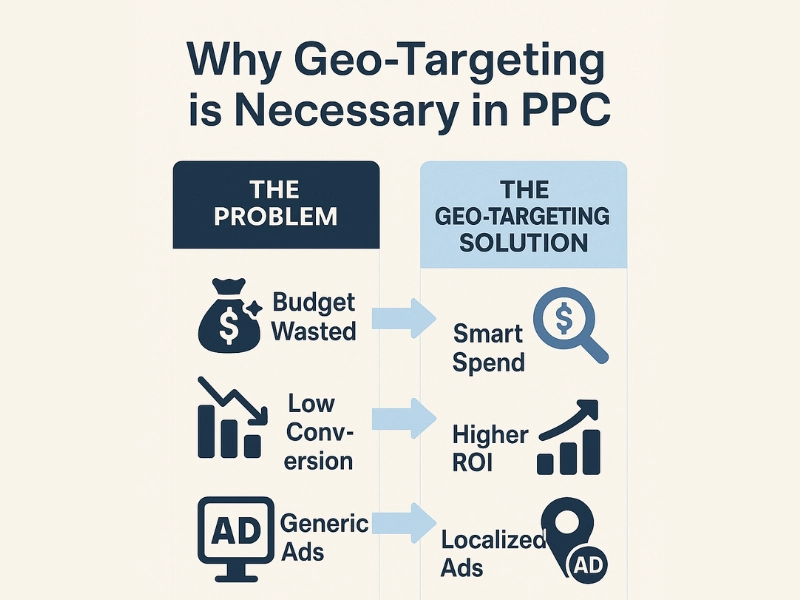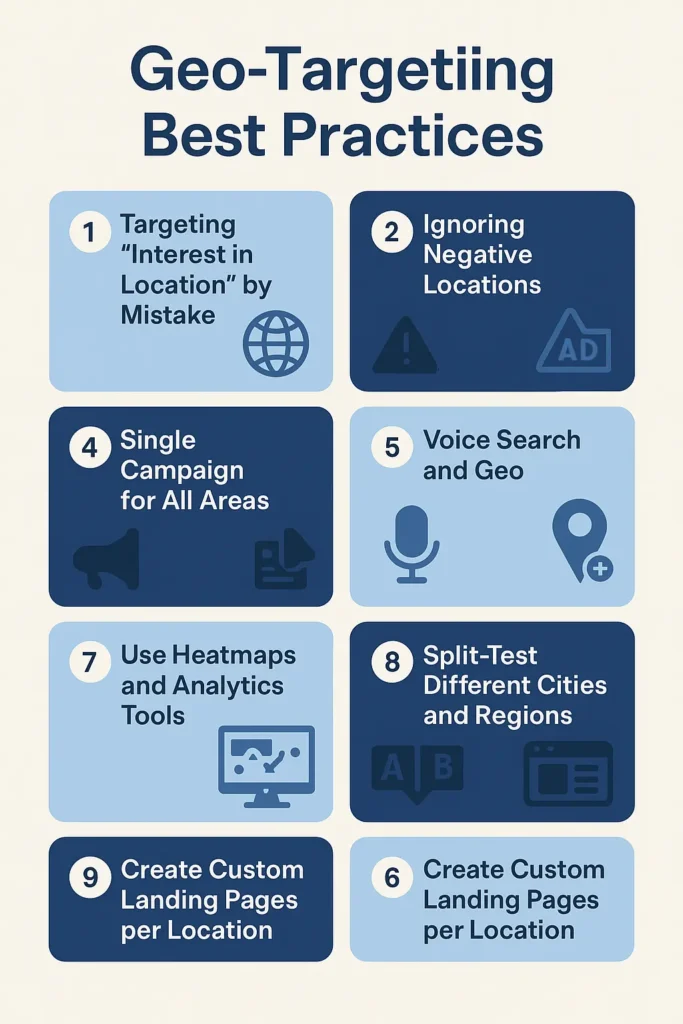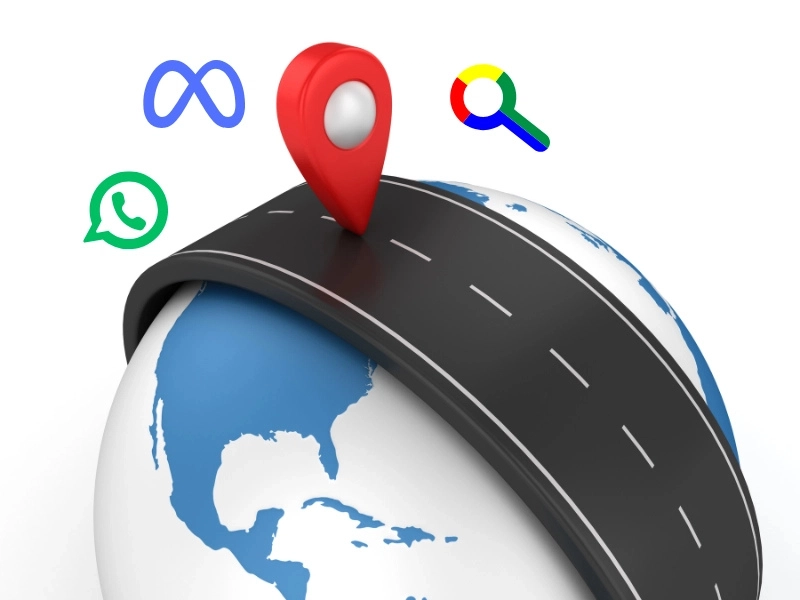Why Geo-Targeting Tactics in PPC are Necessary
Your PPC campaigns are live. The budget is set. The ads are brilliant. Yet, conversions are mediocre, and your cost-per-acquisition is slowly climbing. You broadcast your message to a massive audience, hoping to catch the right person. This scattergun approach burns through your budget. It hits countless people who will never convert. Your message gets lost in the digital noise. Every irrelevant click is money down the drain.
Geo-targeting tactics in PPC are necessary to deliver highly relevant ads to specific geographic audiences, boosting engagement, conversion rates, and ROI by aligning campaigns with local preferences and behaviors. This guide will show you how to master geo-targeting tactics in PPC.
What is Geo-Targeting?
Geo-targeting, or geographic ad targeting, is the practice of delivering advertising content to consumers based on their physical location. This location can be as broad as an entire country or as narrow as a specific radius around a business. The core intent is to connect with individuals most likely to convert, whether they are physically near a business or reside in a region with historically high conversion rates.
AI-powered PPC campaigns enhance geo-targeting tactics by analyzing vast amounts of data to identify high-performing regions, optimize ad spend, and deliver personalized ads to the right audience at the right time, maximizing ROI and engagement.
Major PPC platforms, including Google Ads, Facebook Ads, and Microsoft Ads, integrate geo-targeting capabilities. These platforms leverage various data points to determine a user’s location. These include IP addresses, Wi-Fi networks, Bluetooth signals, cell tower IDs, and GPS data from mobile devices.
Geo-targeting is the single most effective way to ensure your ad spend drives real business results.”
Larry Kim, Founder of WordStream
Why is Geo-Targeting Indispensable in PPC?
Geo-Targeting stems from several key advantages that directly impact campaign effectiveness and profitability.

Enhanced Relevance and Engagement
By focusing on specific geographic areas, advertisers can create highly relevant personalized ad content. This content resonates more deeply with local audiences. For instance, a restaurant can promote a lunch special to users within a few miles of its location. This direct relevance leads to increased engagement and higher click-through rates. A 2019 Factual report highlighted this impact, revealing that 84% of marketers experienced increased engagement after adopting location-based marketing.
Optimized Ad Spend
One of the most compelling benefits of geo-targeting is its ability to minimize wasted ad impressions and clicks. Showing ads to irrelevant audiences drains marketing budgets without yielding results. This precision leads to a more efficient allocation of resources. When ad networks perceive ads as high-quality and relevant, they often reward advertisers with lower Cost-Per-Click (CPC). This directly translates to a better return on ad spend (ROAS).
Driving Local Conversions
For businesses with physical locations, geo-targeting is a powerful tool for driving foot traffic and in-store visits. Statistics underscore this impact: 88% of local search results lead to either a call or a physical store visit within 24 hours. This makes geo-targeting indispensable for brick-and-mortar stores, service providers, and any business relying on local clientele. It bridges the gap between online search and offline action.
Core Geo-Targeting Methods
Geo-targeting offers various levels of precision, from broad national campaigns to hyper-local initiatives. Understanding these core methods is crucial for crafting an effective strategy.
1. Country and Regional Targeting
This is the broadest form of geo-targeting, allowing businesses to target entire countries or large regions within them. It is suitable for brands operating at scale, such as international e-commerce sites or SaaS companies. This method can lack precision for businesses reliant on local demand. It treats all areas within a country as equal, despite varying demand and competition. Without bid adjustments, it can lead to wasted spend.
2. City and Postal Code Targeting
This method allows for more precise targeting of local audiences. It is particularly beneficial for industries like real estate, hospitality, and professional services.
This can be too restrictive if potential customers are willing to travel from outside the targeted area. It requires continuous analysis to avoid missing valuable leads from nearby locations.
3. Radius (Proximity) Targeting
Radius targeting enables advertisers to show ads to users within a defined distance from a specific location, such as a business address. This is ideal for driving foot traffic or serving customers in a limited geographic area. A hotel could set a 10-mile radius around its area to reach high-intent buyers searching for “hotels near me”.
In dense urban areas, a small radius might exclude potential customers willing to travel. In rural areas, a large radius could dilute relevance if the business’s offerings are not compelling enough to attract distant buyers.
4. Tiered Bidding by Location
Not all locations are created equal. Some areas will have higher conversion rates than others. Instead of using a single bid for your entire target area, use tiered bidding. You can increase your bids for high-performing locations and decrease them for lower-performing ones. This strategic allocation of your budget maximizes your return on investment. You spend more where it counts and less where it does not.
This strategy demands continuous optimization. Location performance can fluctuate due to seasonality and local market trends, requiring ongoing monitoring and adjustments.
| Type | Best For | Example Use Case |
| Country | Global brands | Skincare brand selling in US/EU |
| Region/City/Zip | Local businesses | Pizza chain in New York City |
| Radius/Proximity | Physical stores | Yoga studio within 5 miles |
| Geofencing | Events, malls | Push offer when entering a mall |
| Geoconquesting | Stealing competitors | Burger King near McDonald’s |
| Weather-based | Weather-sensitive goods | Umbrella ads on rainy days |
Advanced Geo-Targeting Strategies
Beyond the foundational methods, advanced geo-targeting tactics unlock even greater precision and effectiveness. These strategies leverage deeper insights and real-time conditions to maximize impact.
1. Targeting Based on Location Intent
Google Ads allows targeting users not just by their physical location, but also by their search intent related to a location. This is invaluable for industries like travel, real estate, and luxury goods, where decision-making often precedes physical presence.
Google Ads allows you to target users based on their “presence” or “interest.”
- Presence: This targets people who are physically in your target location.
- Interest: This targets people who have shown interest in your target location, even if they are not physically there. For a travel company, targeting “interest” is more effective.
Implementation: In Google Ads Location Settings, select “Presence or interest” rather than solely targeting those physically present.
2. Competitor Location Targeting
This involves targeting users near competitor locations. It is particularly potent for retail, hospitality, and automotive sales. A luxury car dealership could target users physically at a competing dealership, serving them ads with compelling offers for test drives or trade-in deals.
Implementation: Identify competitor addresses and set up custom radius targeting around those locations. Craft ad copy that highlights unique selling points, such as superior pricing or exclusive offers.
3. Weather-Based Geo-Targeting
Dynamic weather-based targeting triggers ads based on real-time weather conditions, directly influencing consumer behavior. An HVAC company can run ads for air conditioner repair during a heatwave.
Implementation: Utilize Google Ads Scripts or third-party weather APIs to adjust bids and modify ad copy based on local weather conditions.
4. Hyperlocal Targeting with Geofencing
Geofencing creates ultra-precise virtual boundaries. When users enter these defined areas, ads are triggered. This is excellent for real-time engagement, such as promoting in-store offers or event-based advertising.
5. Local Inventory Ads (LIAs)
For retailers with physical stores, Local Inventory Ads (LIAs) display whether a product is in stock at a nearby location. This effectively drives foot traffic. A shoe retailer could show ads stating, “This shoe is available at Axminster,” encouraging shoppers to visit the store rather than buy online.
Implementation: Enable Local Inventory Ads in Google Merchant Center and connect real-time inventory data to Google Ads.
Real Case Studies
Theoretical understanding of geo-targeting is valuable, but real-world examples demonstrate its transformative power. These case studies highlight how businesses have leveraged geo-targeting to achieve remarkable results.
Case Study 1: Scandiweb and Dubai Client
Scandiweb’s PPC team implemented a geo-targeting strategy for a client in Dubai, focusing on Meta ads. Their objective was to increase brand awareness by targeting highly specific locations. They meticulously defined audience locations using maps, scraping tools, and bulk uploads. The campaign targeted new users at the top of the funnel, excluding retargeting visitors.
Results (within 7 days) :
- 8.6 ROAS: One of the highest ROAS achieved by the client from social ads.
- 15% add-to-cart rate
- $10 cost-per-result: One of the lowest costs achieved.
- 9.6% CTR
- 3,266 engagements (comments, follows, messages) on ads.
This case study powerfully illustrates that even highly granular geo-targeting can yield exceptional results, significantly boosting brand awareness and generating healthy ROI.
Case Study: Whole Foods’ Conquest
Whole Foods implemented a brilliant geofencing strategy. They created virtual fences around their competitors’ stores. When shoppers entered these areas, they received mobile ads from Whole Foods highlighting promotions and unique selling points. This aggressive tactic led to a post-click conversion rate of 4.69%, more than triple the industry average. This case study demonstrates the immense power of competitor geofencing.
Implementation: Use Google Ads radius targeting with mobile-preferred ads. Ensure ad creative is highly tailored for immediate action, such as direct discounts or event invitations.
Overcoming Geo-Targeting Challenges
While immensely powerful, geo-targeting presents certain challenges. Addressing these proactively ensures campaign success.
1. Location Setting
One common pitfall is the ambiguity between city and state names. For example, targeting “London City” might inadvertently target the entire state of London if not carefully managed. Advertisers must manually exclude regions they do not wish to cover to ensure precision.
Review all targeted locations and implement manual exclusions for unwanted areas. Double-check keyword relevance to specific geographic intent.
2. Time Zone Management
Failure to account for different time zones across targeted regions can lead to budget depletion before ads reach their intended audience. If a campaign runs across multiple time zones without proper scheduling, ads might stop showing in some areas while others are still active.
Create separate campaigns or ad groups for different time zones. Implement ad scheduling to ensure ads run during optimal hours in each specific region.
3. Data Scarcity and Privacy Concerns
Mobile users are increasingly reluctant to share location data, leading to a reduction in available data for advertisers. Highly specific targeting, especially for niche audiences in small locations, can result in data scarcity, limiting campaign reach.
Focus on maximizing the utility of available data. Prioritize strategically important regions, such as areas with high competitor presence, existing branch offices, or historical high-converting leads. Ensure full compliance with privacy regulations and transparently communicate data usage to users.
4. Performance Review Complexity
Geotargeting often involves launching multiple campaigns for different audiences across various locations. This generates a vast amount of data, making performance review complex. Different regional offices might use platforms and analytics tools, further complicating consolidated analysis.
Implement a centralized data aggregation and reporting system. Standardize analytics tools and reporting metrics across all campaigns and regions. Regularly review performance data to identify trends, optimize strategies, and allocate resources effectively.
5. Location-Specific Landing Pages
Do not send all your traffic to a generic homepage. Create location-specific landing pages. These pages should feature local testimonials, case studies, and contact information. A study by MarketingSherpa found that using location-specific landing pages can increase conversion rates by up to 25%.
Measuring Success
You must constantly monitor and analyze the performance of your geo-targeted campaigns. Google Ads provides detailed reports that show you how your campaigns are performing in different locations.
Key Metrics to Track:
- Click-Through Rate (CTR): Are users in certain locations more likely to click on your ads?
- Conversion Rate: Which locations are driving the most conversions?
- Cost-Per-Acquisition (CPA): How much does it cost to acquire a customer in each location?
- Return on Ad Spend (ROAS): Which locations are providing the best return on your investment?
By analyzing these metrics, you can identify your most valuable locations. You can then refine your targeting and bidding strategies to maximize your results.
Actionable Strategies for Optimal Results
1. Targeting “Interest in Location” by Mistake
Many advertisers unknowingly select the “People interested in this location” setting in Google Ads. This often shows ads to users who aren’t physically in the target area, like travelers or researchers. Unless you’re targeting tourists or planning-focused buyers, always choose “Presence” to reach people currently in your service area.
2. Ignoring Negative Locations
Not all locations are worth your ad spend. If certain cities or regions generate clicks without resulting in conversions, exclude them using negative location targeting. This helps protect your budget and boosts campaign efficiency.
3. Generic Ad Copy
Running the same ad copy for all locations weakens relevance. Always localize your ads by including city names, local slang, or well-known landmarks. For example, “Free delivery in Birmingham” converts better than a generic “Free delivery.”
4. Single Campaign for All Areas
Lumping all locations into a single campaign limits your ability to analyze and improve. Instead, split your campaigns by region, city, or ZIP code to track performance and tailor messaging. This allows smarter budget allocation and better ROI over time.
5. Voice Search and Geo
Voice search queries like “best dentist near me” or “bookstore open now in Manchester” are inherently location-focused. PPC campaigns must consider these natural-language, location-aware queries when selecting keywords and writing ad copy.
Tips:
- Include conversational keywords.
- Use long-tail phrases that match voice search intent.
- Make sure your business has up-to-date local listings.

6. Use Location-Based Ad Extensions
Location extensions help your ads stand out by showing your physical address, phone number, and a clickable map. This is especially useful for local businesses. By linking your ads to your Google My Business (GMB) profile, your ad can appear in Maps and local searches. It also builds trust, as users can instantly verify your legitimacy and get directions.
Pro tip: Add your phone number for mobile users to tap and call directly.
7. Use Heatmaps and Analytics Tools
Visual behavior tools like Hotjar, CrazyEgg, or Microsoft Clarity show where your website visitors are coming from and how they interact with your pages. Use this data to refine your geo-targeting.
For instance, if you notice users from a specific city bouncing quickly or not converting, reassess whether your offer resonates there or consider excluding the location entirely.
8. Split-Test Different Cities and Regions
Don’t assume all areas will perform the same. Set up separate ad groups or campaigns for each city, region, or zip code. This lets you test:
- Which messages resonate in which regions
- Where conversions are strongest
- CPC differences across markets
Once you identify top-performing areas, reallocate more budget to those regions and pause underperformers.
9. Create Custom Landing Pages per Location
Geo-targeting works better when paired with relevant landing pages. If you’re targeting users in Manchester, they shouldn’t land on a generic homepage. Create city-specific pages that reflect the local needs and include regional keywords.
Bonus tip: Include local testimonials or trust signals like “Trusted by 120+ London-based businesses.”

Budget Scaling Tips
- Begin with a small radius or a single city.
- Track performance metrics per location.
- Shift more budget to cities or areas delivering strong ROAS.
- Move from hyperlocal → regional → national only when campaigns are stable.
- Increase bids in profitable regions and lower them in underperforming areas.
Conclusion
Precision matters in geo-targeting. A few small tweaks, like excluding unqualified areas, customizing copy, and using extensions, can boost your ad ROI significantly. Test often, stay data-driven, and always put user intent before ad volume. If you are stuck in geo-targeting PPC, book a free consultation.





